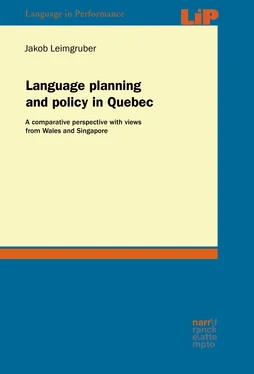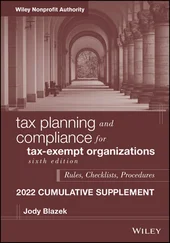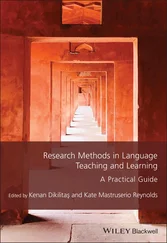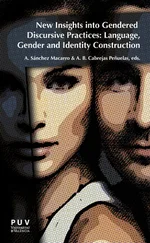Language is not explicitly mentioned in the Quebec Act, perhaps because French was, at the time, the single language of the overwhelming majority of residents in the province. Similarly, French still held the status of a diplomatic language, and was also spoken (in addition to English) by colonial administrators. Nonetheless, a passage in the act can be seen as granting language rights (my emphasis):
[A]ll His Majesty’s Canadian Subjects within the Province of Quebec […] may also hold and enjoy their Property and Possessions, together with all Customs and Usages relative thereto, and all other their Civil Rights , in as large, ample, and beneficial Manner, as if the said Proclamation, Commissions, Ordinances, and other Acts and Instruments had not been made, and as may consist with their Allegiance to His Majesty, and Subjection to the Crown and Parliament of Great Britain […] (Quebec Act 1774, s VIII)
The ‘customs and usages’ may be interpreted to include the French language as customarily and usually spoken in the conquered territory. Furthermore, the French civil laws reinstated with the act were, obviously, written in French, so that by recognising them as laws applicable to the province, their French version would become official, giving French automatically de facto official status.
A century later, the British North America Act 1867 enacted a form of bilingualism at the federal level, without specifically mentioning ‘official’ languages. Its section 133 permitted the use of either English or French in the federal Parliament as well as in the Quebec Legislature; also, both languages could be used in federal and Quebec courts. Records kept and acts passed should be printed and published in both languages, with both versions having force of law.
Yet a century later, with patriation, the statuses of English and French as co-official languages of Canada were reaffirmed and strengthened in the Canadian Charter of Rights and Freedoms (CCRF). This charter forms a part (Part I) of the Constitution Act, 1982 (itself a part (Schedule B) of the Canada Act 1982, a UK parliamentary act), which, together with the BNA Act 1867, forms the bulk of the Canadian constitution.1
The wording in the charter is as follows:
English and French are the official languages of Canada and have equality of status and equal rights and privileges as to their use in all institutions of the Parliament and government of Canada. (Constitution Act, s 16(1))
This constitutionally enshrined bilingualism is applicable to ‘all institutions of the Parliament and government of Canada’ (i.e., federal Parliament and government) in the entire country. Further constitutional linguistic provisions in the CCRF include the bilingual status of the province of New Brunswick (see section 2.4 below), a list of language rights in dealing with institutions of the federal government and with the judiciary, and issues relating to minority language educational rights (i.e. for speakers of French or English in provinces where their language is a minority language).
2.2.1 Bilingualism at the federal level
The constitutional provisions for bilingualism are, in fact, manifestations of pre-existing legal principles outlined in the Official Languages Act 1969 [1985]. This act was passed on the basis of a series of recommendations made by a Royal Commission on Bilingualism and Biculturalism established in 1963, primarily to address the under-representation of Francophones in the federal civil service. A final report in six volumes made recommendations in the field of official languages, education, the workplace, federal institutions, ‘the cultural contribution of the other ethnic Groups’, the federal capital, and voluntary associations. Among these recommendations were bilingual districts for regions of Canada where members of the minority community, either French or English, made up 10 % or more of the local population, that Ottawa should become a bilingual city, and, crucially, that English and French should be declared official languages of Canada. The bilingual status of Ottawa is still a subject of discussion half a century later (Willing, 2016; Commissioner of Official Languages, 2016), and has not, unlike many other provisions, found its way into the Official Languages Act. Its aims are set out in section 2:
The purpose of this Act is to
1 ensure respect for English and French as the official languages of Canada and ensure equality of status and equal rights and privileges as to their use in all federal institutions, in particular with respect to their use in parliamentary proceedings, in legislative and other instruments, in the administration of justice, in communicating with or providing services to the public and in carrying out the work of federal institutions;
2 support the development of English and French linguistic minority communities and generally advance the equality of status and use of the English and French languages within Canadian society; and
3 set out the powers, duties and functions of federal institutions with respect to the official languages of Canada.
(Official Languages Act 1985, s 2)
The equality of status of English and French is enshrined for Parliamentary debates and its reports (section 4(1)); simultaneous interpretation is mandated for debates (s 4(2)), as are translations into the other language of everything that is said in one language (s 4(3)). All federal legislative instruments have to be printed and published in both official languages (s 7).1 Agreements between the federal government and provincial governments also need to be bilingual, with both versions being authoritative (s 10(2)). This latter point of equal authoritativeness is important and repeated in section 13 (my emphasis):
Any journal, record, Act of Parliament, instrument, document, rule, order, regulation, treaty, convention, agreement, notice, advertisement or other matter referred to in this Part that is made, enacted, printed, published or tabled in both official languages shall be made, enacted, printed, published or tabled simultaneously in both languages , and both language versions are equally authoritative
(Official Languages Act 1985, s 13)
The act further regulates the official bilingualism in the judiciary, with federal courts operating in both languages (Part III), and sets rules for communicating and offering services to the public (Part IV). These rules on bilingual services mention where such services should be available: within the National Capital Region (i.e. Ottawa – the city is not officially bilingual, but federal services are available in both languages), and elsewhere ‘where there is significant demand for communications […] in that language’ (s 22(b)).2 It bears noting that these rules apply to all federal institutions, a term that covers, besides parliamentary institutions, governmental departments, federal courts, and any commission or body under the authority of the Crown, also the so-called Crown corporations ( entreprises d’État ), such as Canada Post, the Canadian Broadcasting Corporation, the Royal Canadian Mint, and Via Rail Canada Ltd. All of these companies, which were established by act of Parliament, are federal institutions, and, as such, bound by the provisions of the Official Languages Act. The highly visible and powerful office of the Prime Minister, being federal in nature, also works in both official languages.3 The act itself enjoys high degrees of approval throughout the country, although more so in Quebec and Atlantic Canada than in western Canada and the Prairies (Commissioner of Official Languages, 2016).
A related policy that has gradually emerged since the mid-1960s is that of official multiculturalism, formulated under Pierre Elliott Trudeau’s government in 1971, which culminated in the passing of the Canadian Multiculturalism Act in 1988. It is of relevance here because of its emphasis on language. The act marked a departure from a previous assimilatory policy that saw heterogeneity as detrimental, to a policy of inclusion of all ethnocultural and linguistic groups in the country, enabling all citizens to become a full part of Canada. This was a change already enshrined constitutionally in the Canadian Charter of Rights and Freedoms in 1982, where section 27 states ‘This Charter shall be interpreted in a manner consistent with the preservation and enhancement of the multicultural heritage of Canadians.', making multiculturalism a cornerstone of federal legislation. Together with the Charter’s section 15(1), which bans discrimination based on ( inter alia ) race, ethnicity, and religion (but, crucially, not language), these provisions set the ground for official multiculturalism, which was then legislated, in 1988, into the Canadian Multiculturalism Act.
Читать дальше












